In telescope terms, the part of the telescope that gathers the light is called the optical tube assembly, or OTA. This will have a lens in the front (as in refractors) or a mirror in the back (as in reflectors), or both (as in catadioptrics).
In this discussion, I will focus on three types of optical tube assembly. There are others, but these are the most common in the astronomy hobby market. I will discuss their individual characteristics and what, if any, advantages or drawbacks each type has for the astronomy hobbyist. These are:
- Refractors: based on an objective lens to gather light
- Newtonian reflectors: based on a mirror to gather light
- Catadioptric: based on a combination of lenses and mirrors
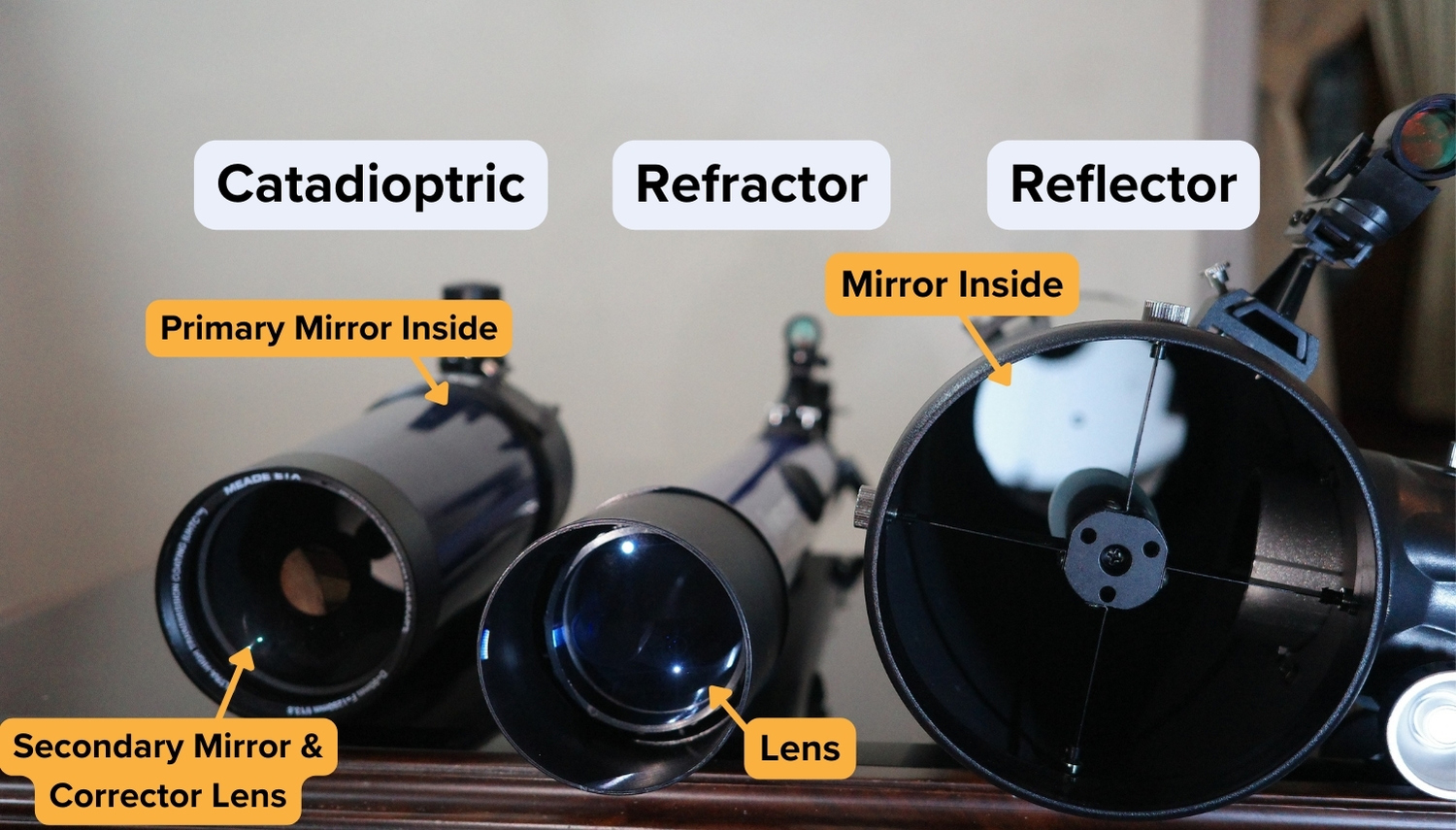
The device that holds the OTA and allows you to point and control it is called the mount. This may be in the form of a tripod or other arrangement. The OTA plus the mount would be called a telescope.
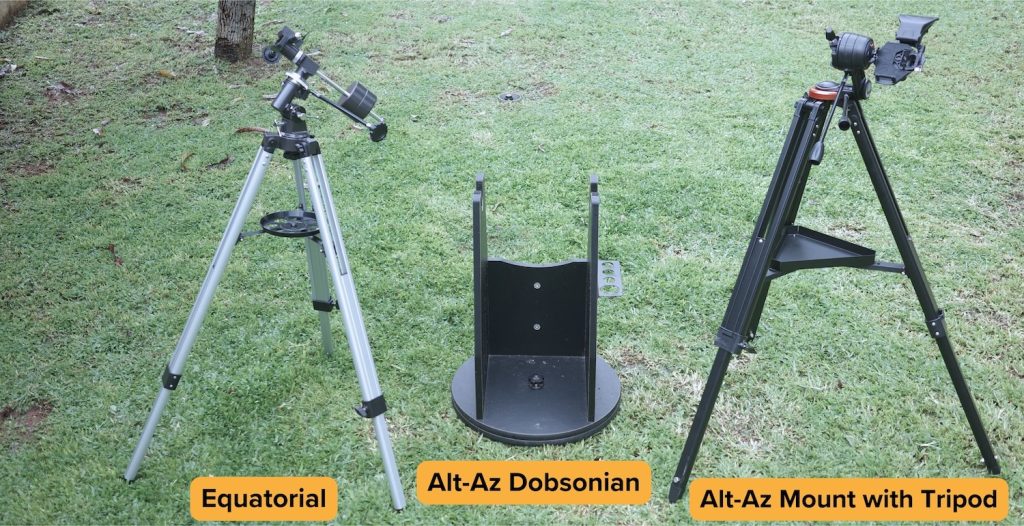
Let me define three terms or specifications that are common to all optical tubes (click on the respective tab to read).
This one is easy. This is the diameter of the primary lens in the front or the primary mirror in the back of the tube.
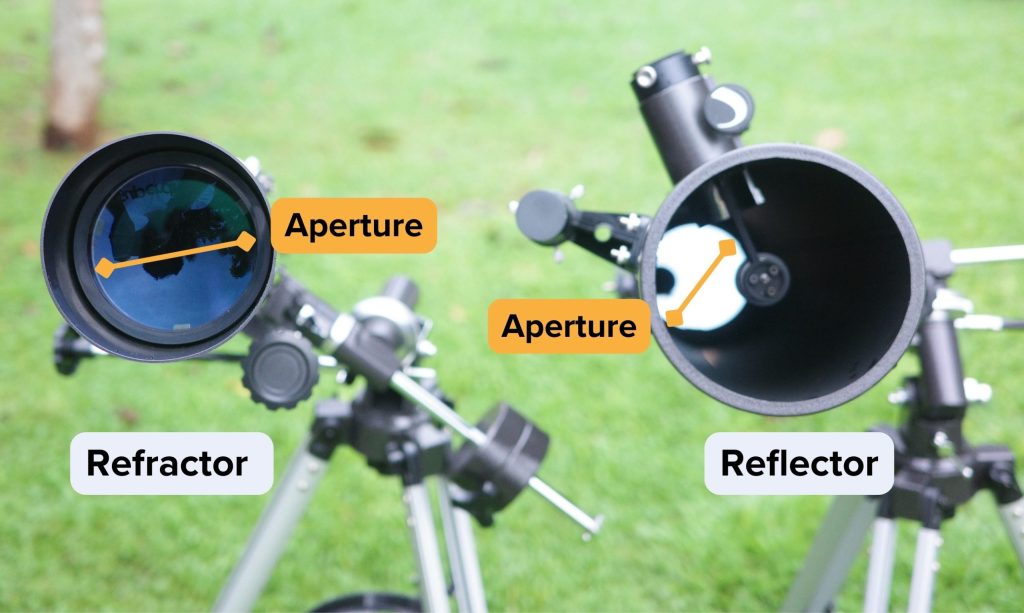
The larger the aperture, the more light the OTA gathers. The more light gathered, the dimmer the objects that can be seen, the more detail that can be seen and the greater the magnification that can be achieved without compromising on the image quality.
Typical apertures in the hobby market range from 50 mm to about 400 mm or about 2 inches to about 16 inches. There are optical tubes larger than 16 inches on the hobby market, but they are more of an exception than a rule.
Whether the telescope uses a lens or a mirror as its primary light-gathering tool, that lens or mirror is shaped to focus the light at a point known as the focus point. Whatever that distance may be, it is called the focal length, shown as f’ in the diagram. It is worth noting that eyepieces, which are made up of lenses, also have a specified focal length.
Take the focal length and divide it by the aperture, and you get the focal ratio. You will see numbers like f/5, f/8, f/10, f/12, f/15, and other variations.
A key thing to keep in mind about focal ratio is that numerically high-focal-ratio optical tubes deliver the light stream to the eyepiece in a much more parallel way than OTAs with low focal ratios. Where this comes into play is how the eyepiece has to handle the light.
A numerically high focal ratio, say over f/10, makes it fairly easy for the eyepiece to present a uniformly good image all the way across its field of view. A numerically low focal ratio OTA, say f/6 or lower, presents the light rays at the edge of the field to the eyepiece at a steeper angle, making it harder for the eyepiece to present a uniformly good image towards the edge of the field of view. This will come up later as we discuss each of the optical tube designs.
Table of Contents
- Type 1: Refractor Telescopes
- Type 2: Newtonian Reflector Telescopes
- Type 3: Catadioptric Telescopes
- MCT vs. SCT vs. Newtonian
- Refractor’s Edge Over Other Designs
- Collimation Requirements of Each Design Type
- Which Type is Right for You?
- A Last Note
Type 1: Refractor Telescopes

Developed in the early 1600s, this is the OTA that was popularised by Galileo Galilei.
A refractor telescope has a curved lens in the front, as in the below image, that gathers light and bends it to the focal point along the focal length of the optical tube.
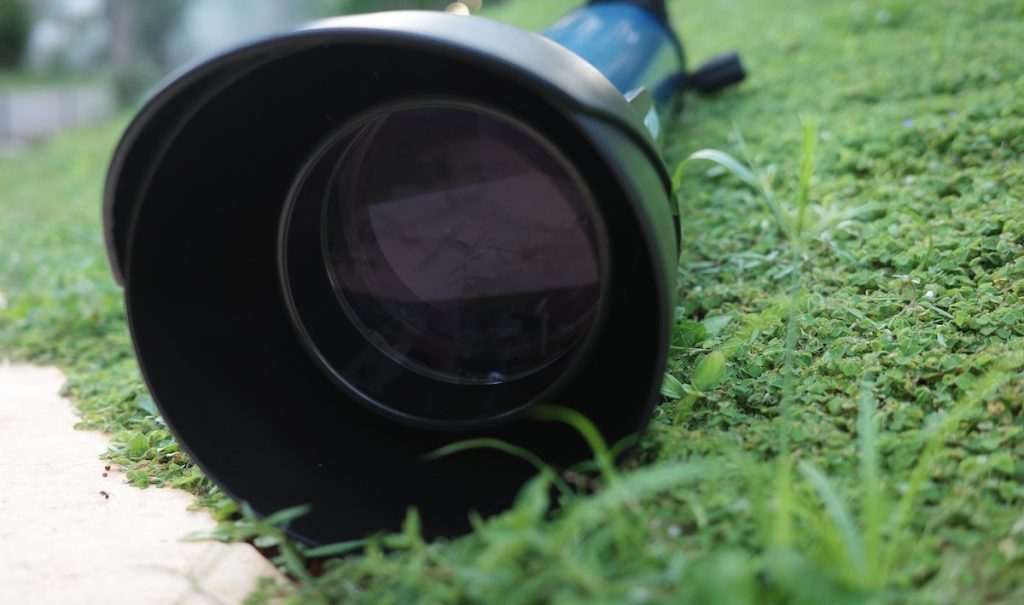
This gathered light will usually hit a mirror or prism device called the diagonal, which directs it to the eyepiece. A focuser moves some part of the optical path in order to bring the light stream to proper focus, creating a sharp image. The eyepiece then magnifies the image and presents it to the eye of the observer or the sensor of a camera.
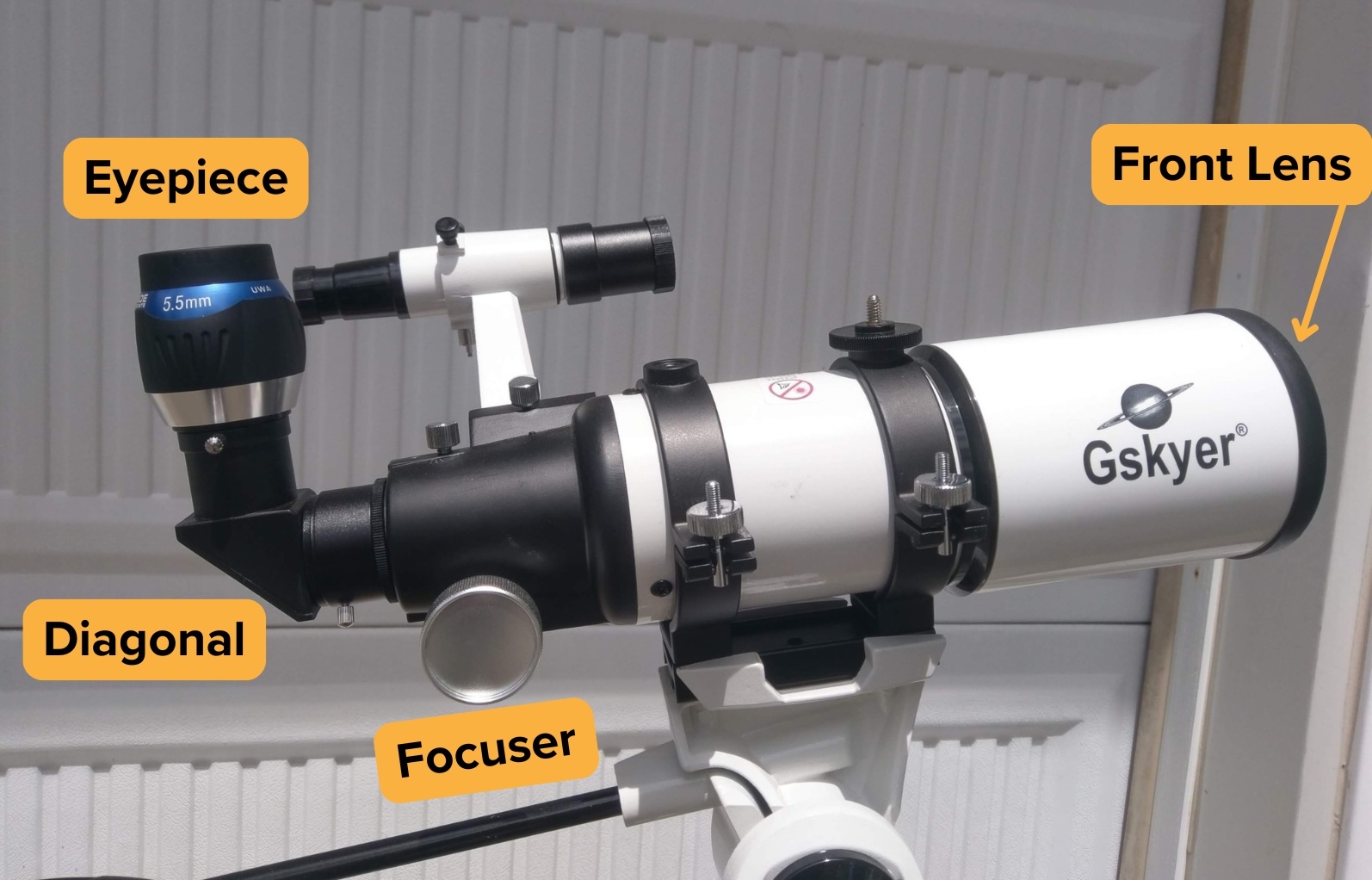
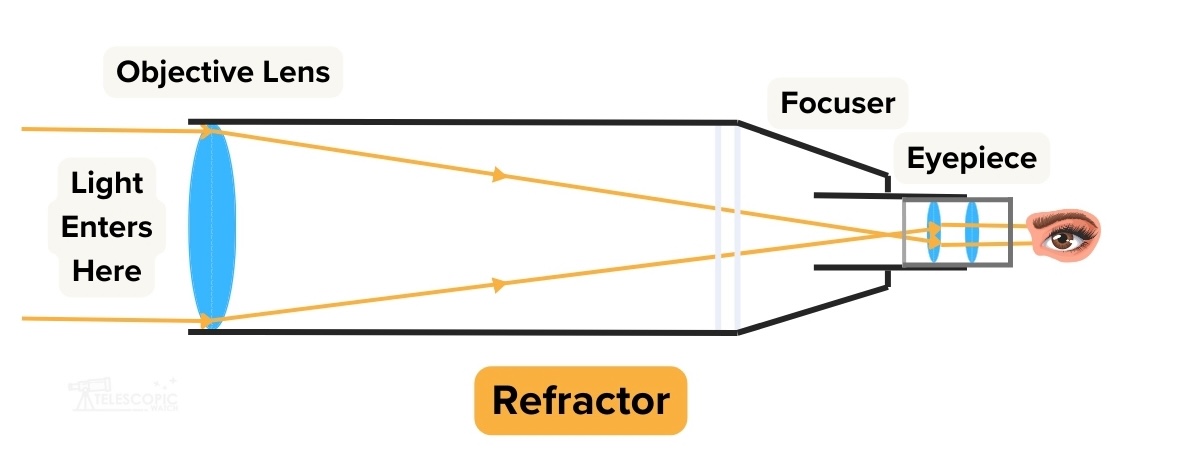
The refractor lens system, when used with a diagonal, produces a correct image up and down but reversed left and right. For astronomy, this is not an issue, as there is no up or down, left or right, in the heavens. But when the refractor design is used for terrestrial purposes such as spotting scopes and binoculars, a correcting prism is to be introduced to correct the image for left and right.
A key characteristic of refractor design is that there is nothing obstructing the optical path, which means the full aperture, the span of the front lens, is available to gather light and present it to the eyepiece. This results in better resolution when compared to some other telescope designs that I will discuss down the road.
The Chromatic Aberration Effect In Refractors
A negative characteristic of refractor design is that light passing through the aperture lens is broken up into its respective colours in a similar fashion to a prism that casts rainbows on the wall. Unfortunately, a side effect of this is that not all of the colour streams arrive at the eyepiece at exactly the same time. As a result, the refractor exhibits chromatic aberration, or false colour, in the image.
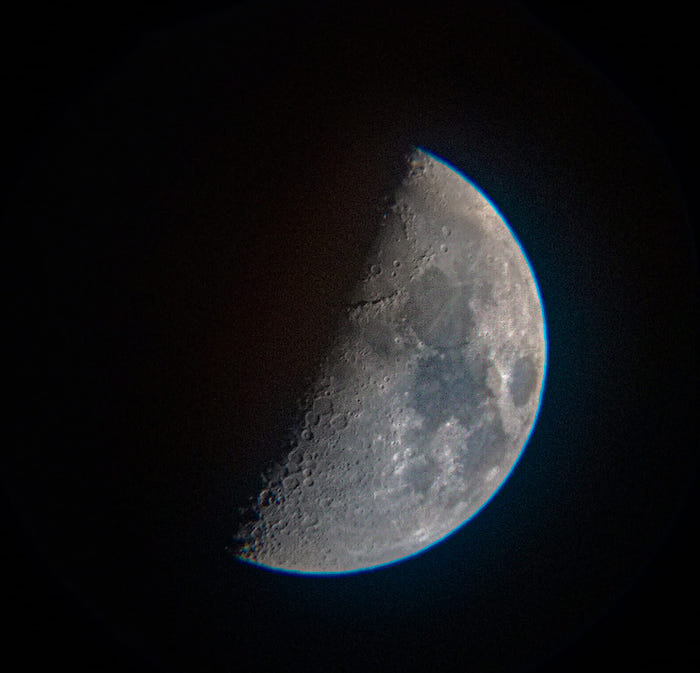
Later developments in refractor designs involved the addition of one or more additional lenses in order to minimise this chromatic aberration. Let’s discuss those:
Solution 1: Achromatic Refractors
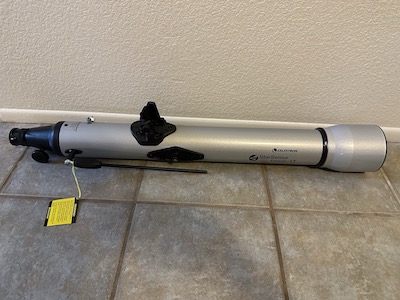
This is the design that I see in almost all low-cost to midrange refractors.
An achromatic refractor uses two lenses, which greatly reduces but does not completely eliminate this chromatic aberration. This colour aberration is most evident with low-focal-ratio refractors and is most noticeable around bright objects. The Moon, for example, might have a blue/purple edge, which is not truly there.
The main benefit of this design is that it is low-cost and makes for a fairly light optical tube.
Solution 2: Apochromatic Refractors
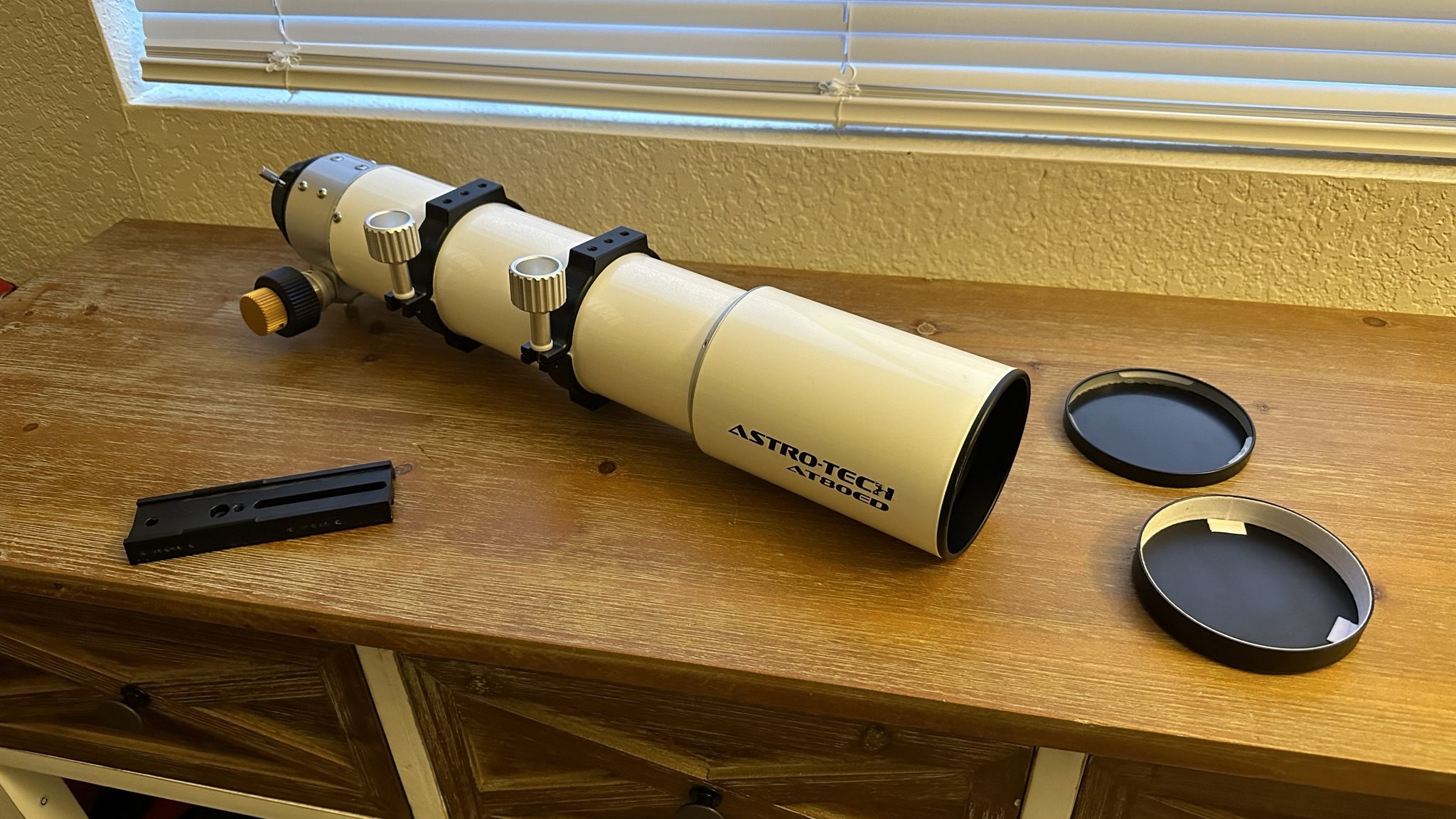
The more advanced refractor form, the apochromatic refractor, introduces specialised ED glass and even sometimes a third lens to further reduce chromatic aberration, especially in low-focal-ratio telescope designs. This results in truer colour rendition that is required for astrophotography and visual observers who demand the best image. However, this also results in a heavier optical tube in addition to being much more expensive.
The Refractor Sizes
In the hobby market, it is rare to see refractors with an aperture of more than 8 inches, as it is difficult and very expensive to produce lenses larger than that. The more common sizes are 5 inches (127 mm) down to about 50 mm (about 2 inches).
Type 2: Newtonian Reflector Telescopes
Developed by Sir Isaac Newton in the mid-1600s, Newtonian reflectors use a mirror rather than a lens to focus the light. A major benefit is that there is no chromatic aberration introduced.
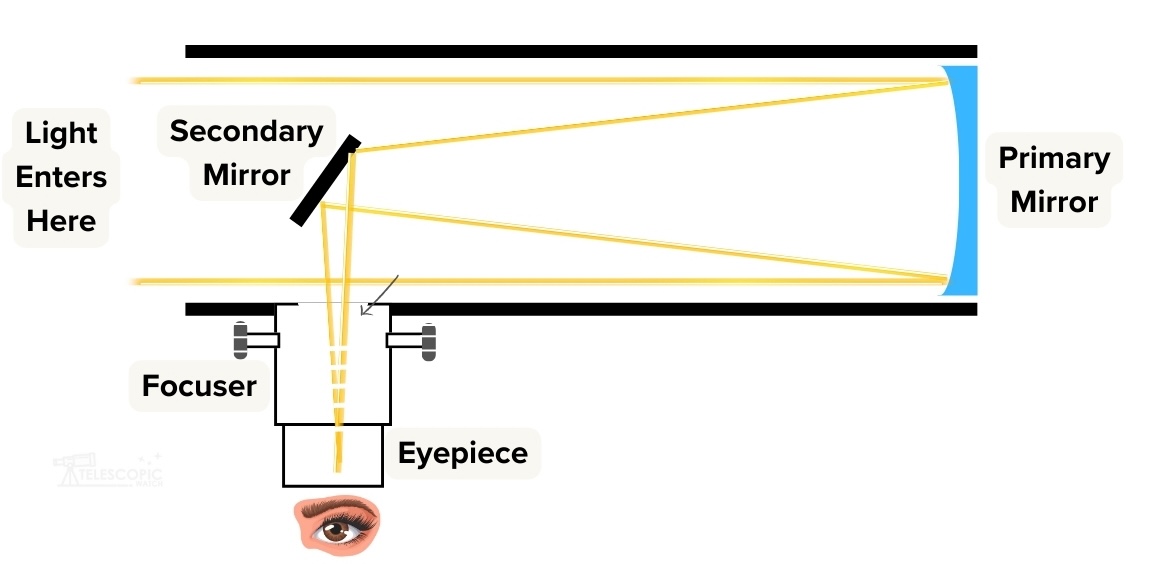
As we see in the diagram, light enters from the left and hits a mirror in the back, which focuses it and sends it to a secondary flat mirror angled at 45 degrees to direct it to the eyepiece. The primary mirror can be spherical in shape, but larger mirrors, typically larger than 100 mm, are usually parabolic.
The Disadvantages of Reflectors: Inverted Image & Less Light Gathering Due to Central Obstruction
The image produced by a Newtonian reflector is inverted. This doesn’t matter much when viewing the sky, but it means that the Newtonian is not suitable for daytime terrestrial use. Seeing the boats on the lake upside down would not be desirable.
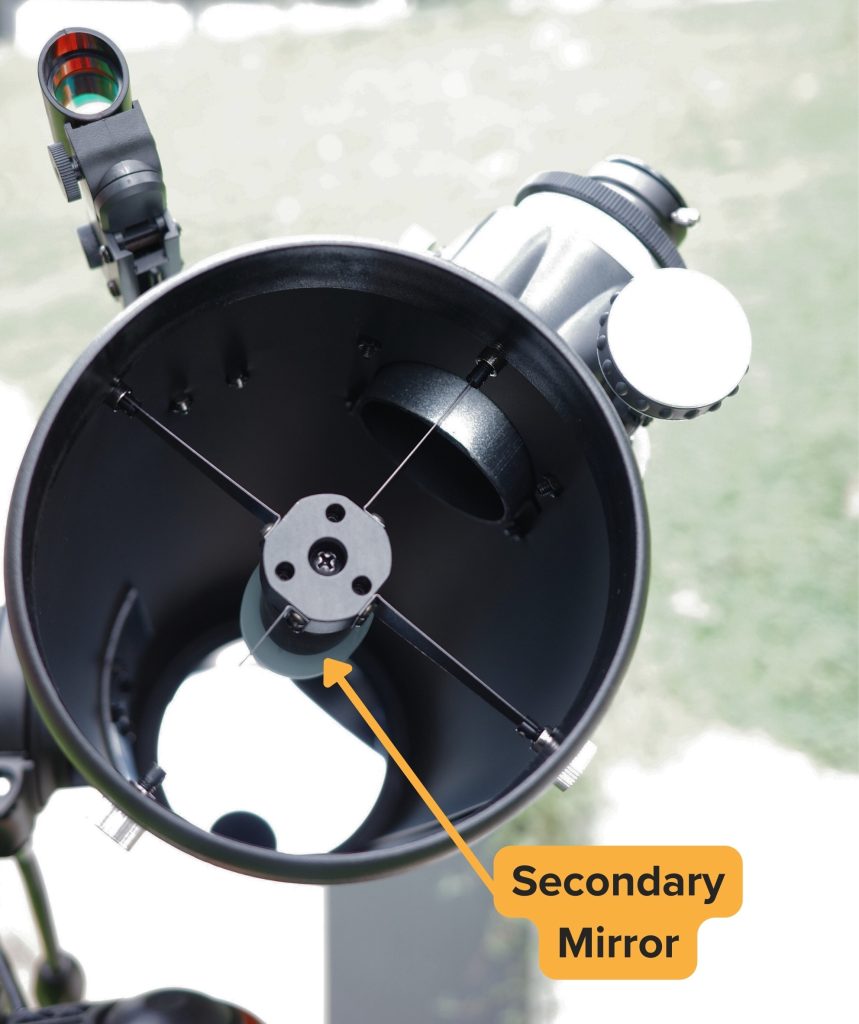
Unlike refractors, we can see that the Newtonian has a central obstruction in the form of the secondary mirror. This indicates that the secondary mirror is blocking some of the light entering the optical tube. As a result of this central obstruction, a refractor telescope of the same aperture can gather more actual light than a Newtonian.
The Advantage of Reflectors: Scalability
Where the Newtonian gains advantage is that it is easier to make big mirrors than big lenses. So the Newtonian design scales up nicely. It is not uncommon to see mass-market Newtonian reflectors with an aperture of up to 16 inches (400 mm) and larger.
Of all the OTA designs I’m discussing here, the Newtonian reflector offers the lowest cost per inch of aperture.
When you get beyond a 16-inch aperture in the hobby market, especially for visual astronomy, the optical tubes are almost all Newtonian reflectors. In the larger designs, typically 14 inches or larger, they go from a solid tube to a truss design that allows the OTA to be taken apart for easier transport.
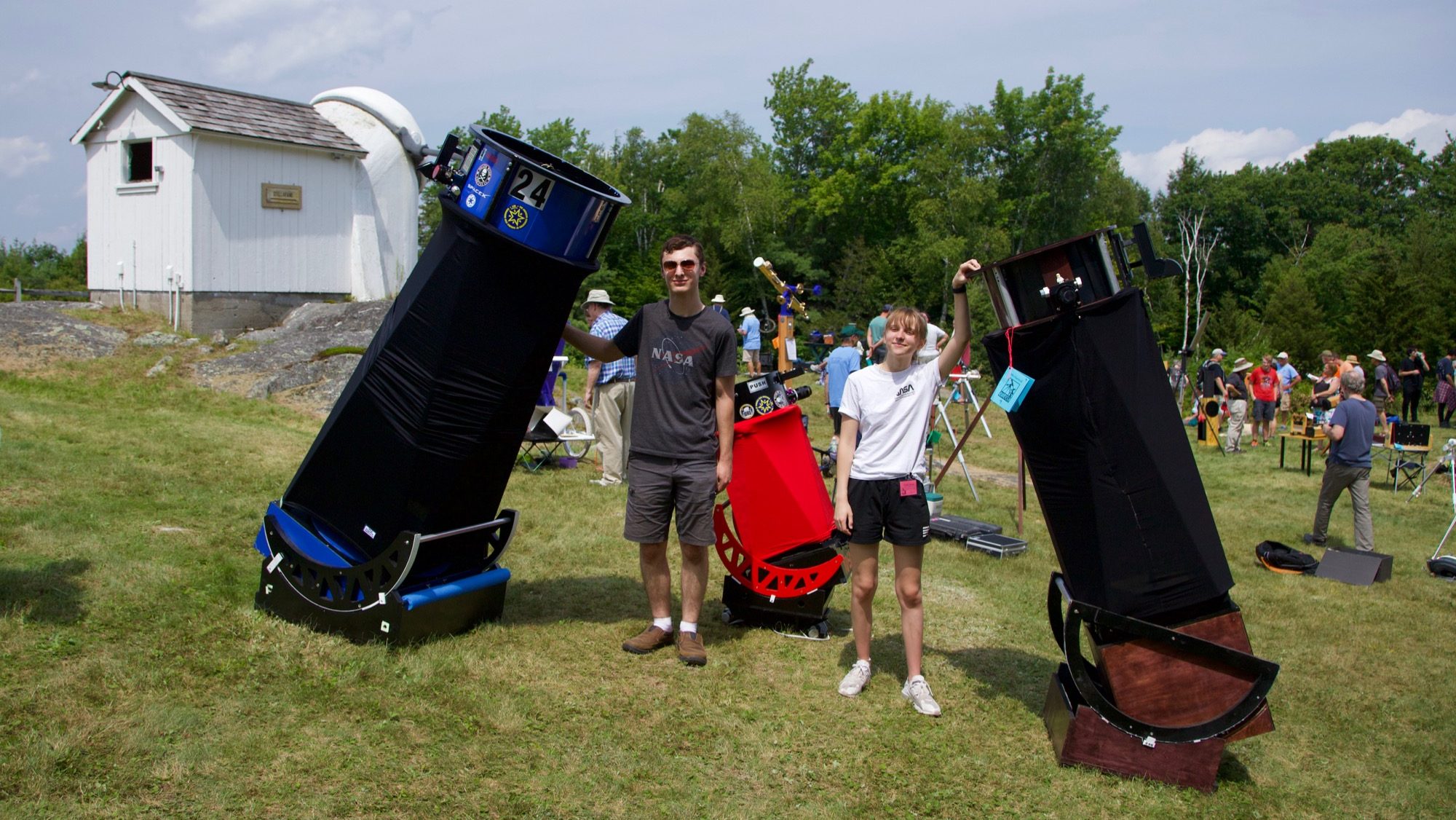
Type 3: Catadioptric Telescopes
In simple terms, a catadioptric optical tube assembly is a combination of lenses and mirrors.
The two most common designs in the hobby market are the Schmidt-Cassegrain telescope, SCT, and the Maksutov-Cassegrain telescope, MCT. They both have a front corrector plate, which is a lens; a secondary reflector, which is usually attached to the corrector plate; and a rear primary mirror with a hole in the centre.
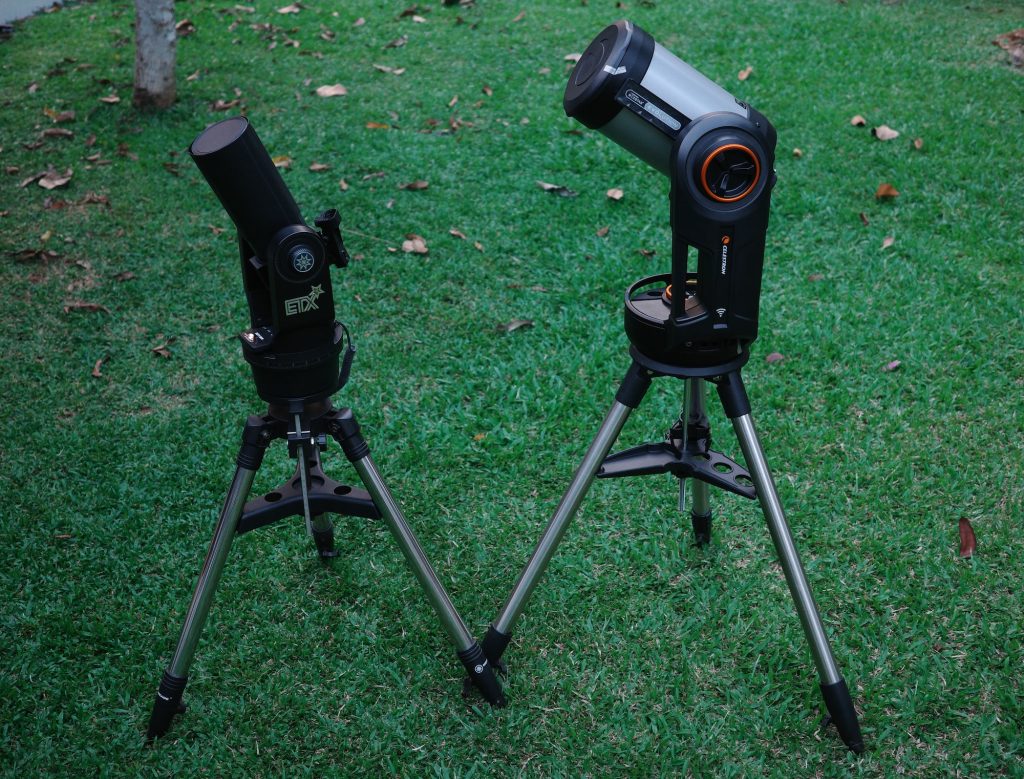
- Schmidt-Cassegrain Telescopes
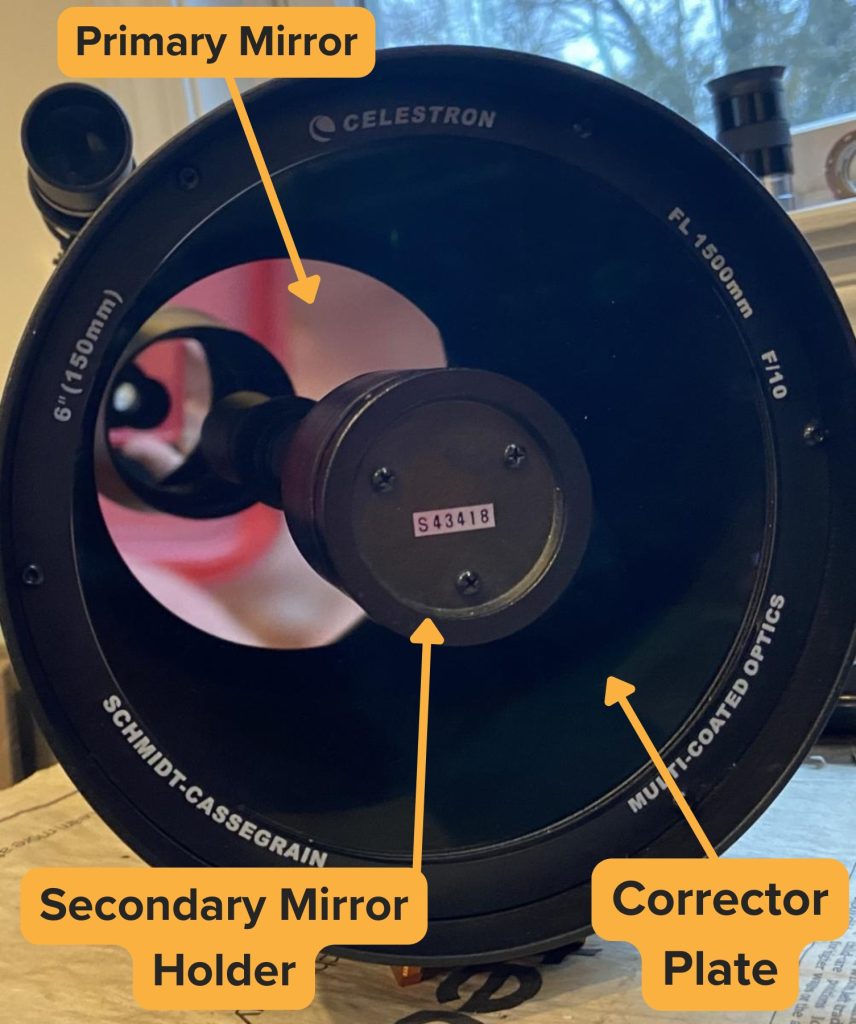
The SCT is based on a spherical corrector plate up front, a spherical secondary mirror, and a spherical primary mirror. The secondary mirror directs the light back through a hole in the primary mirror to the diagonal and then to the eyepiece.
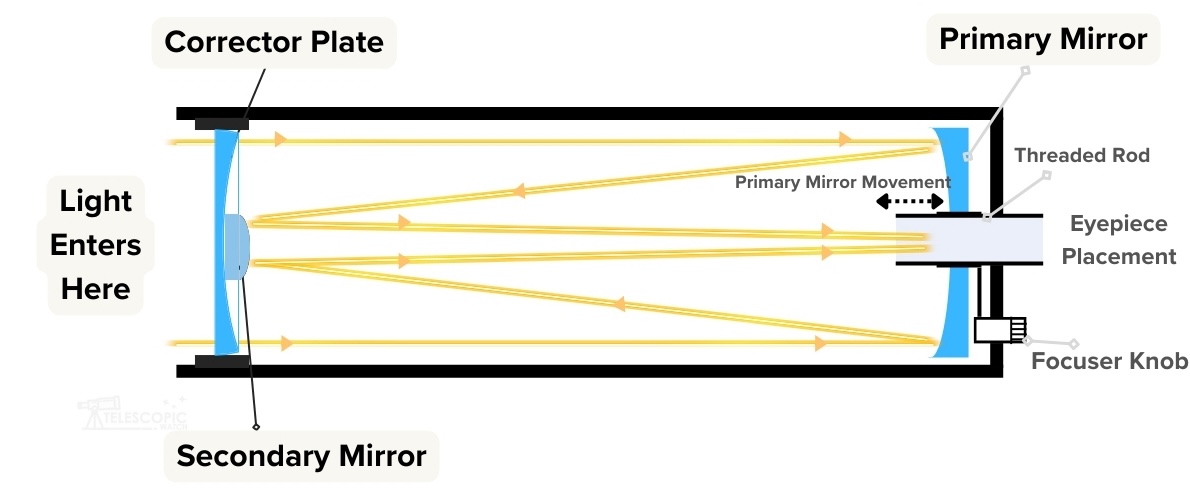
SCTs are extremely popular in the hobby market. Sizes commonly run from 4”/102 mm to 16”/400 mm. Larger sizes are possible but very expensive.
- Maksutov Cassegrain Telescopes
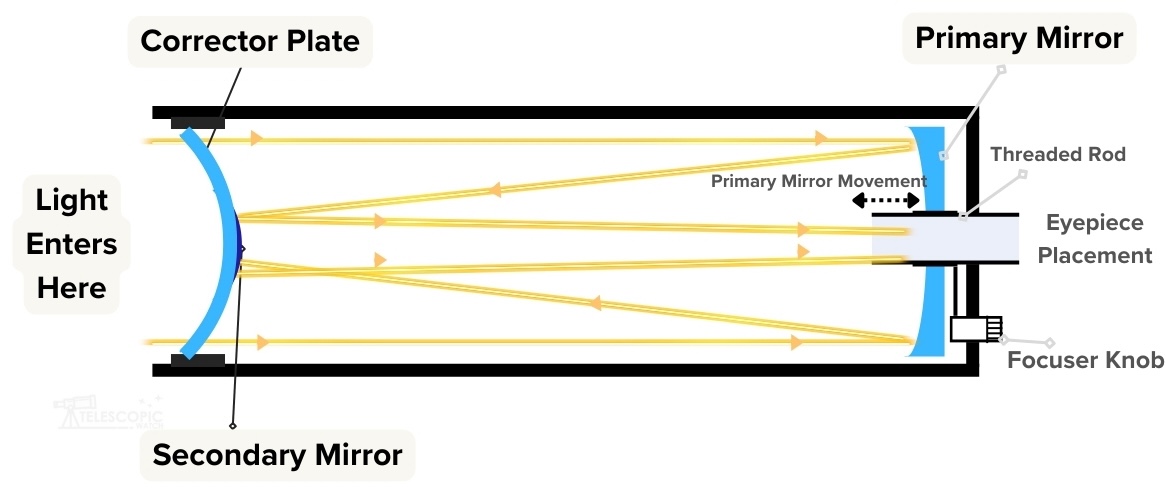
The MCT, as shown in the diagram, appears similar to the SCT except that the corrector plate is based on a thicker convex corrector plate design. And rather than a spherical mirror as the secondary, a silvered area on the back of the corrector plate handles the reflection back through the hole in the spherical primary mirror.
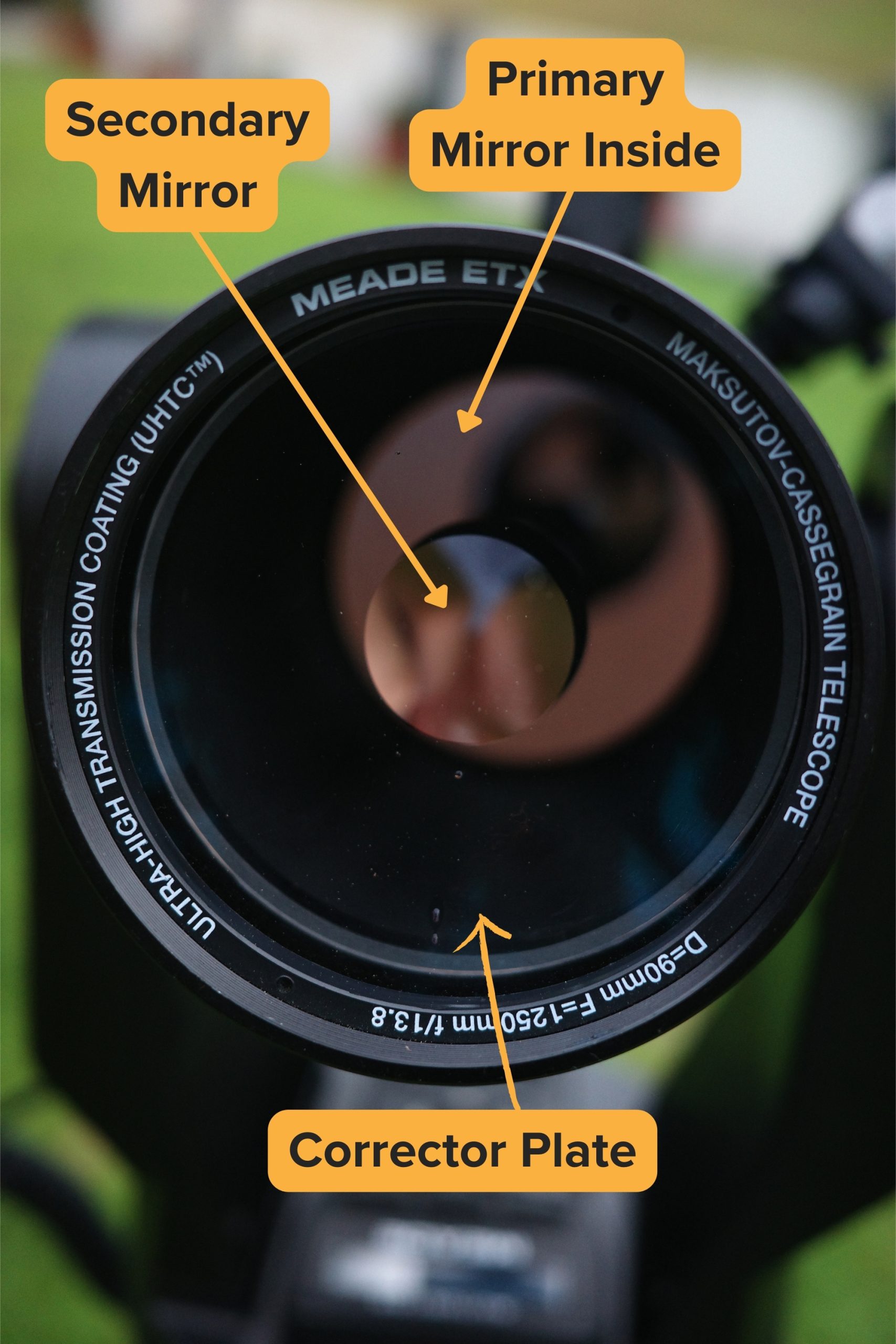
MCTs are common in the 4”/102 mm to 7”/180 mm range. The MCT uses a thicker, and therefore heavier, corrector than the SCT, making it harder to manufacture economically in larger sizes for the hobby market
Major Advantage & Disadvantage of Catadioptrics
As you can see above, both the MCT and SCT designs have a central obstruction in the name of the secondary mirror, like the Newtonian. As a result, part of the light is blocked by that central obstruction.
Their main benefit of the MCT and SCT is that they fold the light path inside the optical tube. This allows for longer focal lengths in a more compact package.
Like the refractor, the MCT and SCT, when used with a diagonal, present a correct image up and down but reversed left and right. You can add a correct diagonal image for daytime use.
Read More: Schmidt-Cassegrain vs Maksutov-Cassegrain
MCT vs. SCT vs. Newtonian
Below are the assumed specifications that you can expect from each telescope design in general.
| Telescope Type | Focal Length | Optical Tube Length | Weight |
|---|---|---|---|
| 8″ f/6 Newtonian | 1200 mm | 48″ | 9 kg |
| 8″ f/10 SCT | 2000 mm | 17″ | 5.5 kg |
| 7″ f/15 MCT | 2700 mm | 22″ | 7.25 kg |
The downside of the SCT and MCT is a higher cost per inch of aperture than the Newtonian design.
Also, their longer focal lengths limit their low-power field of view as compared to the Newtonian. So we consider MCTs and SCTs to be narrow-field-of-view optical tubes as compared to most Newtonians of similar aperture.
Refractor’s Edge Over Other Designs
Refractors have no central obstruction, so a smaller aperture refractor can provide comparable light gathering to a larger Newtonian, SCT, or MCT.
I usually give the refractor about a 1” or 25 mm advantage, but some would advise 2”. So a 4”/102 mm refractor will provide approximately the same light gathering as a 5”/127 mm Newtonian, SCT or MCT. Many would say it is really closer to 6”/150 mm.
Collimation Requirements of Each Design Type
- Newtonians required regular collimation, a process of aligning the mirrors. This only takes a few minutes, once you get the hang of it. Normally, you don’t have to do it every time you use the scope, but it is a maintenance item. Some people do it every time because it only takes a couple of minutes.
- MCTs and SCTs do require collimation, but only rarely. The time intervals can be measured in years in most cases.
- Refractors generally do not need collimation. The rigid mounting of the lenses tends to hold up for the life of the scope. This is one reason why I’d say they make good travel scopes.
Which Type is Right for You?
The primary job of the optical tube assembly is to gather light, and they all do that very well. Each optical tube can be used for planets or deep sky objects. Refractors, SCTs, and MCTs can be used during the day when used with a correct image diagonal.
Purpose: Planetary & Deep Sky Objects (DSO) Observations
- The SCTs and MCTs, due to their long focal lengths, tend to be more optimised for planets and smaller DSOs. Long focal length implies the telescope would have higher magnification and less field of view by default, which is not apt for viewing wide-field DSOs.
- Newtonians and refractors typically occupy medium to short focal lengths, so they often present wider fields of view. This can provide an advantage for wide DSOs, but they can be used on planets as well.
These differences here are more of a shading than a black-and-white cutoff on what optical tubes can be used for what targets.
Purpose: Compatibility & Better Performance With Eyepieces
- The MCT and SCT tend to have focal ratios of f/8 to f/15. This means that they are less demanding on eyepieces. So I can use less expensive, less corrected eyepieces and still get a good view that is fairly clean from edge to edge.
- Newtonians are typically in the f/4 to f/8 range. These are a little more demanding on the correction ability of the eyepiece. Below f/6, this becomes more of a factor. There is a device called a coma corrector that can help with this, or you can simply select better, more expensive eyepieces in order to have a clean image across the field. Many people feel a little edge distortion is tolerable.
- Refractors can run the full range of focal ratios, from f/4 to f/20. So, like the Newtonians, if you are below f/6, give some extra consideration to the types of eyepieces you are buying or what your tolerance is for edge distortion.
Purpose: Travelling
For travel scopes, short-tube refractors and smaller SCTs and MCTs work best. There are small Newtonians but they tend to be bulkier than the others and more likely to get out of alignment from bouncing around during travel.
Spotting scopes, which are typically used for daytime outdoor use, are based on the refractor design. Binoculars are also refractor-based designs. These and astronomical refractors are very popular for travel, as they are fairly rugged and don’t require any maintenance.
If you get a refractor with a shorter focal length, it will show you wide vistas, and many can even fit in a carry-on bag for the airline. If you are focused on planets, you may prefer a longer focal length of the MCT or SCT. Planets don’t require as much aperture as fainter DSOs.
A Last Note
If you become a long-term astronomy hobbyist, you will likely end up with more than one telescope. And you are likely to have more than one type. My experience is that most people end up with:
- Binoculars, which are an implementation of the refractor design
- A grab-and-go scope: smaller and lighter; often in the 70 mm to 150 mm range
- A light bucket, typically 8″ (203 mm) or larger for those fainter deep-sky targets
